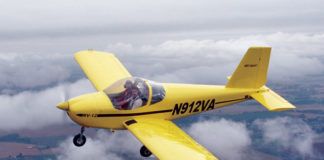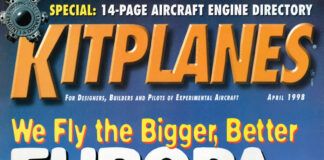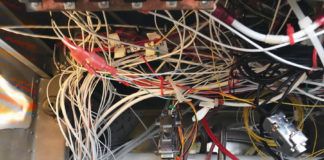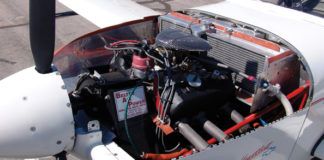Stability and trim are often confused. While both are necessary for smooth, controlled flight, they are quite different. We have just concluded a series on pitch stability and control feel, and this month we turn our attention to pitch trim.
Pitch Trim
Trim is a condition of static equilibrium. When the airplane is in trim, the sum of all of the moments acting on the airplane must be zero. If this is not the case, there will be a net moment on the airplane that causes it to rotate nose up or nose down. To be able to drive the net moment about the center of gravity to zero at any flight condition and any allowable c.g. location, the pilot must be able to adjust the aerodynamic pitching moment the airplane is generating, thus trimming the airplane. Producing this “trimming” moment is one of the functions of the horizontal stabilizer and elevators.
When an airplane is in level flight at constant airspeed, there is one particular elevator position that trims the airplane. This position varies with airspeed, altitude and the loading condition of the airplane. As long as the elevator is held in this position, the airplane will be in trim.
If the stick is released, the elevator will float with the wind. This floating position may or may not trim the airplane to the desired airspeed. It is undesirable for the pilot to have to exert a constant push or pull force on the stick to hold level flight. Ideally, therefore, we would like the elevator to remain floating in the trim position if the pilot releases the controls. Although the airplane is trimmed as long as the elevator is in the right position to establish pitch equilibrium, the pilot will not consider the airplane trimmed until the stick force required to maintain this condition is zero.
Trim Systems
Most airplanes have pitch trim systems that allow the pilot to adjust the stick force to zero at any normal flight condition. In general, these systems work in one of two ways. The first type changes the position at which the elevator will float when the stick is released. The second does not affect the elevator directly. It changes the pitching moment of the airplane itself, thereby changing the airspeed at which the airplane will trim with the stick free. The first class includes trimtabs, “sparrow strainers,” and bungee or spring trim systems. The second class includes variable-incidence tails, aileron reflexers on tandem-wing and canard airplanes, and separate-surface trimmers.
Trimtabs
Trimtabs on the elevators are probably the most common type of pitch-trimming device found on light airplanes. The trimtab is a small plain-flap surface hinged to the trailing edge of the elevator. When it is deflected relative to the elevator, the tab produces a force on the trailing edge of the elevator that changes the position at which the elevator floats. To trim the airplane nose down (for conventional aft-tail airplanes) the tab is deflected trailing edge up. This causes an increase in air pressure on the top of the tab, and a decrease in pressure on the bottom of the tab. The net down-force on the tab pushes the elevator trailing edge down, trimming the airplane to a lower angle of attack. To trim the airplane more nose up, the tab is deflected trailing edge down.
On some simple airplanes that fly at the same airspeed most of the time and have low stick forces, the tab is a simple piece of sheet metal that can be bent on the ground to adjust the trim. Such a fixed tab is used to set the trim for the one airspeed the airplane flies at most of the time.
For most airplanes, however, a fixed tab is inadequate. The airplane must fly over a wide range of airspeeds, altitudes and c.g. positions, all of which change the required elevator setting. The pilot needs a controllable trimtab to trim out stick forces over the entire flight regime of the airplane.
Tabs are relatively simple mechanically, and can be installed on virtually all types of elevator. Another advantage of tabs is that the effectiveness of the tab can be increased relatively easily by making the tab larger without making major revisions to the rest of the airframe.
Tabs also have some disadvantages, and while none of them is prohibitive, all merit consideration. The first disadvantage is that deflecting a tab to trim an elevator reduces the control power of the elevator. To trim an elevator trailing edge up, the tab must put an up-force on the trailing edge of the elevator. This up force opposes the down force that the up-deflected elevator is supposed to
produce, making the elevator deflection less effective. This is not a major problem, but it does mean that a trimtab-equipped elevator must be larger than an elevator that does not have a trimtab to have the same control power.
The second aerodynamic disadvantage of trimtabs is quite minor. If the airplane trims in cruise with the tab deflected, there will be a small parasite drag penalty for the deflected tab. Tabs almost always have external control linkages that also produce a small drag penalty.
One major concern with trimtabs is flutter. It is vital that the linkage controlling the tab be stiff and free of slop. Trimtabs are quite susceptible to flutter if not rigidly constrained by the linkage, and a fluttering tab can drive a flutter of the whole elevator. Flutter can have catastrophic consequences, so the design of a trimtab and its control linkage must be done carefully.
Sparrow Strainers
On some airplanes, rather than adding a fixed tab to the elevators, the designer places a small, auxiliary airfoil on booms aft of the trailing edge. This device has come to be called a sparrow strainer, and they are quite common on canard and tandem-wing homebuilt airplanes. The sparrow strainer works on the elevator in much the same way that a horizontal tail works on the wing of a conventional airplane. The smaller airfoil “steers” the larger one.
The reason sparrow strainers have appeared on so many canards is that unlike aft-tail airplanes, canards fly with the elevators developing a large lift. Typical control surfaces do not float at a position that promotes high lift. The lift on the elevators tries to deflect the elevator trailing edge up. To combat this and keep the elevator floating in the proper position, the sparrow strainer is added. The small trimming airfoil is mounted with negative incidence, much like the tail of a conventional airplane. The sparrow strainer airfoil produces a down force at the end of its booms that forces the elevator to fly in a more trailing-edge-down position.
The primary advantage of sparrow strainers is that moving the trim surface aft onto booms increases the moment arm that it has to act on and increases its effectiveness. This allows the sparrow strainer to trim the elevator with much less down force than a tab would require to do the same job. This is the primary reason they are used on canard airplanes, where relatively large trimming moments are needed to make the elevator float in the right position.
Sparrow strainers are rarely adjustable in flight, as the linkages and hinges required to move them are somewhat tricky to design. Usually they are used to set the basic trim position of the elevators, and another trim device is used for fine adjustment in flight. The only real disadvantage of sparrow strainers is that they are relatively fragile and easy to damage in ground handling.
Spring/Bungee Trim Systems
One simple way of relieving stick forces is to attach a spring or a bungee to the stick that provides a force that opposes the stick force. This type of trim system is used on a number of airplanes, including the Schweitzer 1-26 and 2-33 gliders. The spring or bungee systems primary advantage is its mechanical simplicity. No linkages must be routed to the tail of the airplane. Usually, some method of varying spring tension is provided so the pilot can trim the airplane as airspeed varies.
There are two disadvantages to bungee trim systems. The first is that they can be annoying to the pilot. If the spring is strong enough to trim the highest stick forces the airplane will generate, then the spring forces will be of the same order as the aerodynamic forces acting on the controls. The pilots feel will therefore be composed of roughly equal parts of spring force and aerodynamic force, and he will be flying the spring as much as he is flying the airplane. If the spring system is not properly designed, the spring can interfere with control feel, make the stick forces excessively heavy, and make the airplane unpleasant to fly, particularly during maneuvering. On the other hand, spring systems, if properly designed, can also be used to tailor and improve the control feel of an airplane.
Another disadvantage of spring trim systems is that their effectiveness varies with airspeed. The spring exerts a constant force on the stick. The force exerted by the elevators varies with airspeed. Thus, with a fixed spring setting, the position of the elevators will change as airspeed varies. It turns out that if the spring is pushing on the stick (producing a trailing-edge-down moment on the elevators) this effect is stabilizing, and if the spring is pulling on the stick, the effect is destabilizing. In fact down-springs are a way of artificially increasing the speed stability of certified airplanes, and are quite common on commuter airliners and similar large twins.
All of the trim devices we have discussed up to now work by changing the position of the elevator for zero stick force. We now turn our attention to systems that change the pitching moment of the airplane without directly affecting the elevators. By changing the pitching moment of the airplane, we also change the elevator position at which the airplane trims. If we change it enough, we can get the airplane to trim with the elevator floating.
Variable-Incidence Tails
A common trim system that does not directly affect the elevators is a variable-incidence tail. Instead of being rigidly fixed to the airplane, the forward portion of the horizontal tail is mounted on a hinge so that its incidence can be varied. The airplane is then trimmed by changing the angle of incidence of the whole horizontal tail. This system has appeared on such diverse airplanes as the J-3 Cub and most jet airliners.
The variable-incidence tail is less flutter-prone than a trimtab system and has the advantage of offering a lot of trim control power. It also eliminates the reduction in control power caused by the tab fighting the elevator. For high-speed airplanes, such as jet airliners, the variable-incidence tail has the advantage that it is less susceptible to Mach number effects than the elevator alone.
Variable-incidence tails are usually heavier than tails using trimtabs. The linkage that controls the horizontal tail must be stronger and heavier than a trimtab linkage, and the hinges on which the movable tail rides also add weight.
A second potential disadvantage of variable-incidence tails is the gap between the movable horizontal tail and the fuselage. Air leaking through this gap can cause significant drag. If the gap is large enough, the lift-curve slope of the entire horizontal tail may be reduced, decreasing the stability of the airplane. It is important that the gap be well sealed. This can be difficult, especially if the fuselage sides are curved in the area where the tail is mounted. One interesting solution to this problem, which is used on Mooneys, is to hinge the entire aft end of the fuselage. On Mooneys, the entire tail assembly, including the vertical fin and rudder, is hinged to allow adjustment of the tail incidence for trim.
A final consideration when designing a variable-incidence tail system is that the control forces in the linkage controlling the tail can be quite large if the hinges are not placed properly. Unlike tab systems, the trim control of a variable-incidence tail system is moving a large surface that can generate large aerodynamic forces.
Separate-Surface Trimmers
Another way of adjusting the pitching moment of the airplane is to have a surface, other than the horizontal tail, which is adjustable in flight. There are airplanes that have small, additional horizontal surfaces that can be adjusted in incidence to trim the airplane. One example of such surfaces is the mini T-tail on some Dyke Deltas. Similar small horizontal surfaces have sprouted on some Quickie-type airplanes. The only real disadvantage of these additional tails is that they add drag and weight, though if the surfaces are small, so is the penalty.
Aileron reflexing on the Q-200 and similar airplanes is another example of separate-surface trim. The rear wing on the Q-200 is far enough aft of the c.g. that the ailerons can act as elevators if they are deflected together instead of differentially. Reflexing both ailerons trailing edge up reduces the lift of the rear wing and produces a nose-up pitching moment. As far as I know, aileron reflexing was added to the Q-200 to compensate for the loss of elevator power that occurred on some versions of the Q-2 and Q-200 when rain or dirt disturbed the laminar airflow over the forward wing and elevator. The aileron reflexers should also be usable as a normal trim system.
A major caution to all designers and modifiers of airplanes: The pitch trim system should never be able to overpower the pilot. Some systems, particularly variable-incidence tails, can produce large pitching moments and large stick forces. It is important that they not be so large as to render the airplane uncontrollable in the event of a trim runaway or jam.













